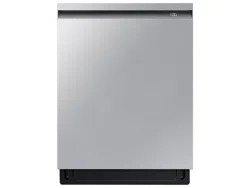Documents: Go to download!
User Manual
- User Manual - (English, French, Spanish)
- Warranty - (English)
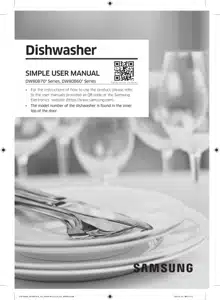
- Using your dishwasher
- Maintenance
- Troubleshooting
Table of contents
User Manual
Using your dishwasher
Basic use of racks
Angle of the plate supports
In the Lower rack, you can easily fold down the fold-down tines to make room for large items such as pots and pans in the Storm Wash+ area. Remove the rack from the dishwasher, and then fold down the tines one at a time. See the illustration below.
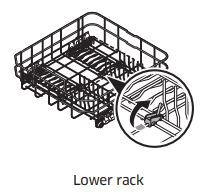
In the Upper rack, you can adjust the angle of the tines to two different positions to match the size and shape of your dishes. To adjust the tines, grasp the handle at the front of the rack, and then push it left or right. See the illustration below.
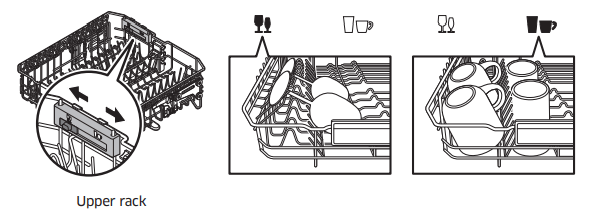
Height adjustment
You can adjust the height of the upper rack in your Samsung dishwasher so that the lower rack can accommodate larger sized dishes. Depending on where you set the upper rack height, the lower rack can accommodate plates up to 12 in. (30 cm) in diameter and the upper rack can accommodated plates up to 8 in. (20 cm) in diameter.
To raise the upper rack
Pull the upper rack upwards. The adjustable handle will latch, and the upper rack will rise.
To lower the upper rack
Hold both the adjustable handles located at the left and right sides of the upper rack, and then evenly press down.
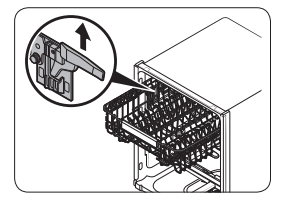
Loading dishes
Loading the lower rack
The lower rack has been especially designed for dinner dishes, soup bowls, plates, pots, lids, casserole dishes, and plates. Load large items such as pans and pots into the dishwasher so their open sides face downwards. We recommend loading cups, stemware, and small plates into the upper rack. See the recommended loading patterns below.

Loading the Storm Wash+ Area
For more effective cleaning, load large items into the Storm Wash+ area on the left side of the lower rack (Red zone). When you select Storm Wash+, the dishwasher supplies additional power to reinforce the water jet in the Storm Wash+ area. Make sure pot handles and other items do not interfere with the rotation of the nozzles.
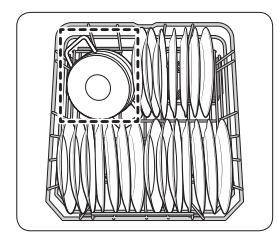
CAUTION
- Take caution not to clog the hot air outlet of SmartDry in the right corner of the lower basket. Clogged outlet will not facilitate heat circulation.
- Keep plastic dishes away from the hot air outlet of SmartDry as they are vulnerable to heat.
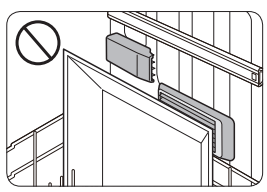
Loading the upper rack
The upper rack has been designed for small plates, mugs, glasses, and plastic items marked “dishwasher safe”. Load your plates into the dishwasher in two half rows, so that the front of each plate faces the back of the plate in front of it, and the open sides of the plates at the center of the dishwasher face each other. See the illustrations below. Make sure the loaded dishes do not interfere with the rotation of the nozzle which is located at the bottom of the upper rack. (Check this by rotating the nozzle by hand.) When loading dishes, pull the upper rack out sufficiently so you can load it without striking the counter above.
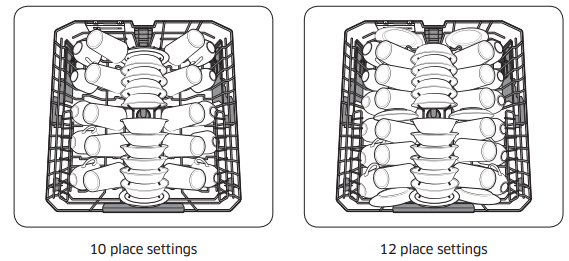
Using the glass support
The glass support is especially suited for wine glasses. Hang wine glasses onto the pegs of the glass support. Fold the glass support back when it is not being used.
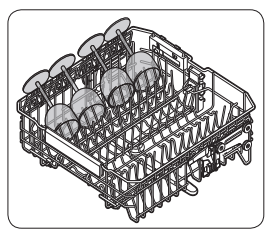
Loading the 3rd RackTM
The cutlery rack is best suited for flatware and cooking or serving utensils. Use it with the spoon stands in the lower basket. You can load cutlery and utensils in the 3rd rack or the spoon stands in the lower basket.
Removing the Cutlery Rack
The entire cutlery rack can be removed if more space is needed on the upper rack for larger items. (See the “To remove the 3rd Rack” section in full user manual.)
Loading the Cutlery rack
The cutlery rack consists of two compartments. You can place each knife, spoon, or fork separately into the spoon stands in the basket’s covers to prevent chipping and discoloration. See the illustrations below. You can use the cutlery rack with the cover open. Refer to the illustration on the left.
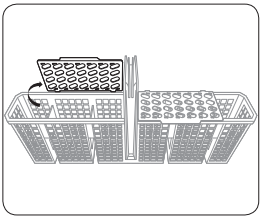
Detergent guidelines
All dishwasher cycles require detergent in the detergent compartment. Apply detergent as appropriate for the selected cycle to ensure best performance.
To fill the detergent dispenser
1. Gently press the dispenser flap to unlock, and then slide it open. Note that the dispenser flap opens at the end of each cycle.
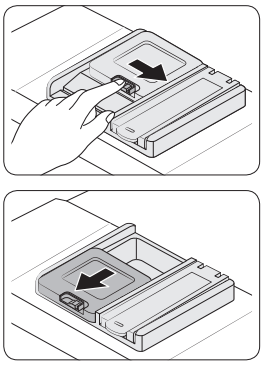
2. Apply the recommended amount of detergent to the main compartment.
3. Close the flap, and then press down to lock.

Rinse aid
Rinse aid improves the drying performance of the dishwasher. When the Rinse Refill indicator lights up on the control panel, refill with rinse aid. Only use liquid rinse aid. Powdered rinse aid will clog the compartment opening and cause the dishwasher to malfunction.
1. Pull up the cap of the rinse compartment to open.
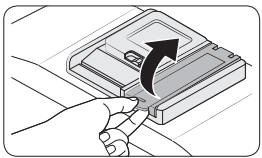
2. Fill the compartment with rinse aid as specified by the rinse aid manufacturer.

NOTE For more information on setting the rinse aid amount, refer full user manual at samsung.com website.
3. Press down the circle area of the cap to close.

Maintenance
Cleaning
Keep the dishwasher clean to improve performance, reduce unnecessary repairs, and lengthen its lifecycle.
Exterior
Clean spills on the surface of the dishwasher as they occur. Use a soft, damp cloth on the control panel to gently wipe away spills and dust.
CAUTION
- Do not use benzene, wax, thinner, chlorine bleach, alcohol, or other chemical substances. These materials may discolour the surface of the dishwasher and cause stains.
- The dishwasher has electric parts inside. Do not sprinkle water directly onto the dishwasher. Protect electrical components from coming in contact with water.
- For a stainless-steel door panel, clean using a stainless steel cleaner for home appliances and a clean, soft cloth.
Interior
Clean the interior of the dishwasher on a regular basis to remove any dirt or food particles. Wipe inside the dishwasher and inside the door with a wet dishcloth. To maintain optimum cleanliness, we recommend running the Self Clean cycle periodically with the dishwasher empty.
To keep the cutlery pad clean, turn it over after each use. To remove white spots and odors from the cutlery pad, run the Self Clean cycle with the dishwasher empty and no detergent until the cutlery pad flushes. Then, stop the cycle and put an 8-ounce cup of white vinegar into the lower basket. Close the door, and then resume the cycle.
Use a damp cloth to remove lime scale or grease deposits inside the dishwasher. Alternatively, apply some detergent, and then run an empty cycle using the highest rinse temperature.
Filter
We recommend cleaning the filter every month.
1. Open the door, and then remove the lower rack.
2. Turn the filter handle counterclockwise to unlock the filter cover.
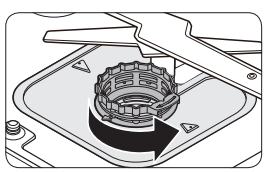
3. Remove the filter cover, and then the cylindrical micro filter underneath.

4. Remove any dirt and impurities from the micro filter and the filter cover.
5. Rinse them with running water, and then dry well.
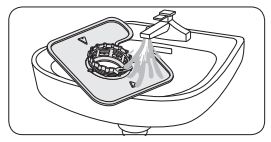
6. Reinsert the filter, and then the filter cover.
7. Turn the filter handle clockwise to lock.
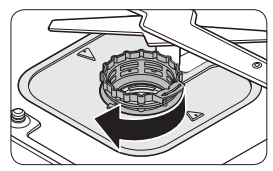
Troubleshooting
CHECK THESE POINTS IF YOUR DISHWASHER…
Will not start.
- The door is not closed completely.
- Check if the door is latched and closed completely. Check whether the Upper Rack is properly joined to the Duct Nozzle.
- Also, check if the Upper Rack is crooked or unbalanced.
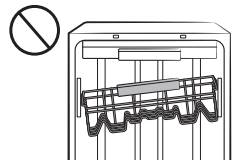
- The START button was not pressed.
- See the information code that appears on the display.
- Doesn't operate at all.
- Make sure the power cable is connected properly.
- The water supply does not work.
- Check if the water supply valve is open.
- Check if the supplied water pressure is between 20 and 120 psi (between 140 and 830 kPa).
- The Control Panel is locked.
- Unlock the Control Lock.
* Refer full user manual at Samsung.com website.
- A circuit breaker is open.
- Reset the circuit breaker.
An operation or cycle is taking too long.
- The dishwasher is connected to a cold water supply.
- Check if the water supply line is connected to a cold water supply. To work properly, the dishwasher must be connected to a hot water supply. (If connected to a cold water supply, additional time is required to heat the cold water.)
There are food particles remaining on dishes. (Not cleaning properly.)
- The cycle selected was unsuitable.
- Select a cycle according to the number and soil level of the dishes, as directed in this manual.
- The water temperature is low.
- Connect the water supply line to a hot water supply. For best performance, the temperature of the supplied water should be 120 ˚F (49 ˚C).
- Low water pressure.
- The water pressure should be between 20 and 120 psi (140-830 kPa).
- The water is too hard.
- Use a commercial dishwasher cleaner.
- Use high-quality, fresh detergent with rinse aid.
- Dishwasher detergent was not used.
- Use automatic dishwasher detergent.
- We recommend a powder type or multi-function tablet dishwasher detergent.
- Detergent remains in the dispenser.
- Make sure large items such as cookie sheets, cutting boards, or contaners, etc. are not blocking the detergent dispenser and preventing it from opening properly.
- Rearrange the dishes so they do not interfere with detergent dispenser operation.
- There is no rinse aid.
- Check the dispenser and add rinse aid.
- Use liquid type rinse aid.
- A nozzle is clogged.
- Clean the nozzle. * Refer full user manual at Samsung.com website.
- The dishes are improperly loaded. Too many dishes have been loaded.
- Rearrange the dishes so they do not interfere with nozzle rotation and detergent dispenser operation.
- Load only an appropriate number of dishes.
- Load your dishes as recommended. * Refer full user manual at Samsung.com website.
- Load the heavily soiled items into the Storm Wash+ area. * Refer full user manual at Samsung.com website.
- The filters are clogged or not correctly fastened. (Food soils remain on the filter.)
- Scrape food from dishes prior to loading. (Do not pre-rinse.)
- Clean the filter. * Refer full user manual at Samsung.com website.
- Make sure the filters are correctly fastened.
- Less water than required is supplied.
- Check if the supplied water pressure is between 20 and 120 psi (between 140 and 830 kPa)
Leaves glasses with a dull film.
- The water supplied is soft and too much detergent was used.
- Underload the dishwasher and use a rinse aid to minimize this.
- Aluminum dishes were included in the wash load.
- Remove the marks on the dishes using a low sensitivity cleaner.
Leaves a yellow or brown film on the inside of the dishwasher.
- This is caused by coffee and tea soils.
- Remove the soils using a spot cleaner.
- Use a cycle with a higher temperature.
Does not dry dishes well.
- There is no rinse aid in the dispenser.
- Check the dispenser and add rinse aid.
- Check the rinse aid settings
- Use a liquid type rinse aid.
- The temperature of the water is low when the dishwasher is running.
- Connect the water supply line to a hot water supply.
- Use rinse aid with the Sanitize or SmartDry option.
- Too many dishes have been loaded.
- Proper loading of items can affect drying.
- Load your dishes as recommended.
- Glasses and cups with concave bottoms hold water. This water may spill onto other items when
- After the cycle finishes, empty the lower rack first and then the upper rack. This will prevent water from dripping from the upper rack onto the dishes in the lower rack.
- Auto Release™ Dry is turned off.
- Turn Auto Release™ Dry on. Press the Lower Rack + Hi-Temp Wash button for 3 seconds to access the Auto Release™ Dry menu. Select "A1" to activate Auto Release™ Dry.
- Multiple detergent tablets were used without selecting the Sanitize option.
- Select the Sanitize option or use rinse aid.
Has a bad odor.
- Water was left over from an incomplete cycle. nd run the Normal cycle
- With the dishwasher empty, add detergent to the dispenser, then dishwasher
- The Drain Hose is obstructed.
- Contact a qualified service technician to remove any obstruction from the drain hose.
- The dishwasher is not used daily or soiled dishes are left in unit too long.
- With the dishwasher empty and no detergent in the dispenser, place a glass with 8 ounces of vinegar upright into the lower rack, and then run a Normal cycle.
Is too noisy.
- Sound is generated when the dispenser cover is open and the drain pump is operating in an early stage.
- This is normal operation.
- The dishwasher is not level.
- Ensure the dishwasher is level.
- Foreign material (a screw, a plastic piece) is in the pump chamber.
- Contact a qualified service technician to remove foreign material from the pump chamber.
- There is a ‘chopping’ sound because a nozzle is bumping against the dishes.
- Rearrange the dishes.
Does not have a smoothly rotating nozzle.
- The nozzle hole is clogged with food particles..
- Clean the nozzle hole .
- The nozzle is blocked by a dish or pot and cannot rotate.
- After placing the dishes into the racks, rotate the nozzles by hand to check whether any of the dishes interfere with them.
Water won’t pump out of the dishwasher.
- The drain is clogged.
- Clean the drain pump by removing the drain-pump cover
Has a bent upper rack after loading dishes.
- The dishes are not loaded properly.
- Load your dishes as recommended.
Cannot close the door.
- AutoRelease™ Dry mode is in operation.
- Once the door opens in the AutoRelease™ Dry mode, the door cannot be closed manually for the next 2 minutes. You may close the door after 2 minutes.
INFORMATION CODES
The Control Panel displays information codes to help you understand what is occurring with your dishwasher
LC
- Leakage check
- If a water supply valve connection leak occurs, close the water supply valve and go to your house circuit breaker panel, set the dishwasher’s circuit breaker switch to off , and then contact the installer to fix.
- If the problem continues, contact an authorized Samsung service center.
4C
- Water supply check
- Check if the water supply valve is closed, the water supply is suspended, or the water inlet valve or line is frozen or clogged by foreign particles.If the problem continues, close the water supply valve, and then contact an authorized Samsung service center.
5C
- Drain check
- After closing the water supply valve, check whether the drain hose is clogged or folded. Also, check whether drain hole inside sump is clogged.
- If the problem continues, contact an authorized Samsung service center.
HC
- High temperature heating check
- The product ensure that the temperature for hot water line is not too high and adjusts to appropriate temperature (120 ˚F (49 ˚C) - 149 ˚F (65 ˚C)) automatically. If the problem continues, go to your house circuit breaker panel, set the dishwasher’s circuit breaker switch to off , and then contact an authorized Samsung service center.
3C
- Pump operation check
- Functional check. Turn off the dishwasher and try to start it again. If the problem continues, contact an authorized Samsung service center.
PC
- Zone wash function check.
- Functional check. Turn off the dishwasher and try to start it again. If the problem continues, contact an authorized Samsung service center.
HC2
- Dry heater failure check.
- Turn the dishwasher off and turn it back on. Then, try again. If the problem continues, contact an authorized Samsung service center.
HC4
- Dry heater overheat check.
- Unplug the power cord of the dishwasher before contacting an authorized Samsung service center.
See other models: DW80B7071US/AA RF29BB8600QLAA RF24BB6200QLAA RF30BB69006MAA RF24BB6600QLAA
